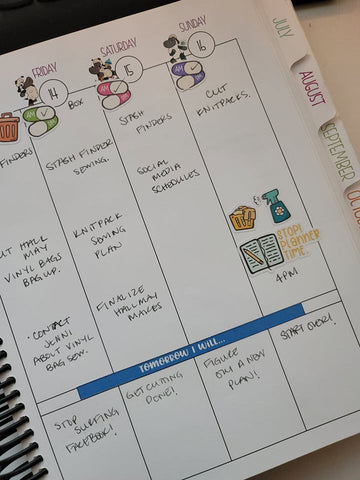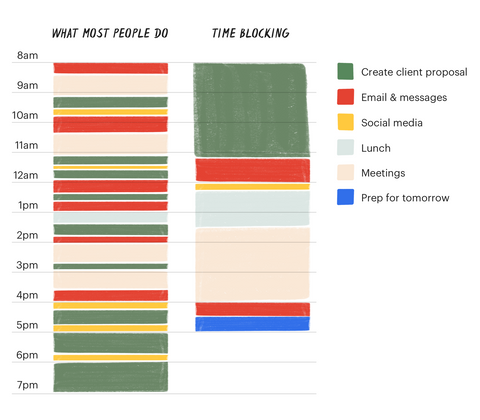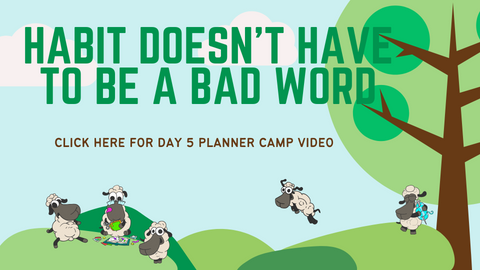Ahh, The New Year Planner (possible) Debacle.
If you have ever roamed Pinterest for any period of time, you probably, like me, have seen some amazing planner spreads. Plan 365, Happy Planner, Erin Condren, Bullet Journals, the list goes on and on. They are always lovely and inspiring, and make me want to have a beautiful planner myself. As a person who was a teacher, I used a planner daily, sometimes hourly to get everything together for my kiddos. But I also noticed. They never used theirs.
After about 3 years of teaching and recycling 100s if not thousands of basically empty planners, I decided it was time to teach my kiddos how to use a planner. Turns out lots of people decide that Pinterest is the way, buy a planner, have lots of big goals, and then throw their planners away mostly empty at the end of the year with a feeling of defeat. Well, here we are: let's learn to use a planner. The following is what I would teach my students, with some new data of course, as well as making sure it fits into the real world of mom's, knitters, crocheters, and of course, general life.
Each day there is a new video posted live in our Facebook group, which you can join here (Erin Lane Bag Buddies) But in case you need more of it written out, here is a shorter synopsis of each day's video.
Planner Camp Day 1: I have a planner; now what?
Why do I always buy a planner, and then never use it?
Well, the sad fact is you were probably never taught how. I know when I taught I handed out the planners given to me by the district to my students, and then nothing was done. Why? Because it's not assessed on a test. So teachers aren't told to teach it. It's not your fault. The fact is that you are 42% more likely to achieve your goals when you write them down.
It seems so overwhelming!
Of course looking at a full year of your life feels overwhleming. Looking 365 of anything would make you feel overwhelmed. Why would planning be any different. Also, again, you weren't taught how to do this, so you feel like you are stumbling in the dark. The key is to break it into small pieces. (We will talk about more on day 2).
You start strong and then fade out.
You have to look at your planner ever day. It needs to be a habit. Check it, write notes in it. It doesn't have to be perfect or pretty. It was meant to be used. So use it. All day if needed. Made an important phone call? Write down the highlights on that day. Had an emergency crop up? Write down what you had to move. It's not written in stone, you can move things around. That's how life goes.
I used all these pretty stickers, but I don't look at my planner.
Sometimes less is more. Don't feel overwhelmed by the idea that your planner has to be a magical piece of art. It doesn't. The spreads you see on Instagram and Pinterest are probably not those people's real planners. They are influencer posts that make them money by presenting the product (stickers/planners/pen) in the most beautiful way possible.
Planners can also make us feel like we have way more time than we do. I might have a huge box on my planner with only a few words in it, but those few words might take you ALL DAY. Be realistic about your time.

When you get your planner, you need to make sure that you ask yourself the following questions.
- Why did I buy this planner?
- What do I want to accomplish?
- How do I want this to look?
The key is to be realistic in your answers. But start small, don't jump into the deep end. That sets you up for failure. Set yourself up for success. Add the things you know first: birthdays, anniversaries, school holidays, doctor's appointments. Then work small. One week at a time. That way you don't get super overwhelmed.
Day 2: Brains, Paper, and Plans. OH MY!
Your brain (in super, super simple terms.)
Your brain is made up of millions of dendrites. These dendrites connect to form synapsis. Why do you care? Because a synapsis is the beginning of a memory, new piece of information, or new pathway in your brain. But in a sly trick of fate, your two dendrites do not touch to pass information between them. They have a space the information has to jump between. In the same way that jumping across a river can end up in disaster, sometimes the information doesn't make it all the way across. But your brain has a solution.
Myelin.
This is a layer that forms around the synapsis to make sure that information gets to from one side of the synapsis to the other. But how to you make myelin? Easy. Practice. The more you use the pathway in your brain the easier it is to remember things. That's why you might be able to remember your 8th grade locker combination, but not the password you reset on your account last night.
Note taking and your brain.
In this ever advancing age of technology, you will find more and more students using computers for their notes. But science says it's the least effective way to learn something.
When you physically write something down on paper (or now digitally with new tablet pens) you have to stop and process that information to get the most important things down. When you type, because it's faster than writing, you just type everything being taught to you.
The process your brain goes through when you write something, physically, with your hand, is called encoding. It forces your brain to create a pathway for the information. Because your brain receives millions of points of data in a short period of time, it has to sort through the trash for the treasure. If you write it down, you brain goes, "Wait, we are using our hands for something! This must be important! I will put this here so I can remember it!"
This is probably the reason that when you write something down to remember, you rarely need to look at it, and when you don't write it down, you NEVER remember it despite telling yourself you will.
Your brain will discard 40% of everything you learn in a day (interesting how you are 42% more likely to succeed at a goal if you write it down isn't it.) Your brain is constantly making sure there is space for what you will learn/need to do, so it, sort of, takes out the trash each night when you sleep. So if you really want to remember something, write it down. This is why people who have plans for their time are more effective. They know what has to be done when. Without that, if you're like me, you might scroll Facebook and lose 2 hours.
How to plan!
As much as I wish there was a one size fits all way to plan, that is not the case. You have to find what works for you.
Here are a few ways to get started:
- Plan by Day –
- Have a daily lists of tasks
- Like a routine list
- Great for kids or significant other
- List of tasks everyone has to complete
- Plan by week-
- Make a list of all things need finished by week’s end
- Check off as you go
- Plan by task:
- Lists of things in categories
- Cleaning, cooking, self care,
- Often also categorized by week/day/month
No matter how you decide to plan, just go for it. It's just paper. If you mess up, there is an eraser, white out, or a sticker that can cover up the mistake. Just start. It doesn't have to be perfect. Just get things written down, so you have more space in your brain to solve other problems. There's only so many things you can focus on at a time. Writing out a plan or even a list of to do's will help your brain have more space for other things, like what to cast on next!
Day 3: Get those goals!
All planning is dependent on setting goals.
You've been setting goals all your life, they were just not written down. You learned to knit or crochet, right? That was a goal, and you did it! YAY! YOU!
But how did you achieve that goal?
If you watched online tutorials, why was that effective? Because you could pause and rewind? So seeing it over and over, like you were, wait for it, building a pathway in your brain?!
If you learned from a book, did you look at the diagrams more than once? Did you try and make your hands look just like the pictures? Why did that work? Because you did it over and over? Like you were, wait for it, building a pathway in your brain?!
If someone taught you in person, did they show you over and over? Put their hands over yours? Why did that work? Because they helped you do it over and over, like you were, wait for it, building a pathway in your brain?!
If you learned both to knit and crochet, did the skills from your first craft help you with your second? Why would that be, I wonder? Because there was pathway in your brain that you could use to learn something new? OH MY GOSH! It all ties together.
Planning Turns Abstract into Concrete
"For most people, the challenge at work isn't keeping busy hour by hour or day by day, it's making sure we get the big-picture projects done that make work fulfilling. These are often broad, abstract goals that you hope to achieve over a period of weeks or months. The problem, though is that they're hard to achieve without breaking them into a coherent set of concrete actions you can take on a daily, weekly, and monthly basis." -FastCo.
Writing a goal is like building a bridge. If I say to someone, "Sew this bag" they will not be successful. I need to tell them how to cut the fabric, what the steps are to assembling the bag for them to be successful.
When you write down a goal, you can see the holes in the plan.
"I want to make a sweater," Is too broad. What kind of sweater? For whom? What size? What yarn? So "I want to make a sweater." Becomes "I want to knit a sweater for myself out of X yarn with a colorwork yoke by X date."
Writing it down shows you what you need to know. I want to make a sweater is easy to push aside. It is so hard, there is so many options, I don't know what to do. I will do it later. The point of goal setting is to make sure you have a finish line. When you have a finish line, you can break things into smaller tasks; and therefore, make more progress toward your goal. "I want to make a sweater" could send you down a days long pattern search on Ravlery. Knowing all those other details, means you can narrow your search.
SMART Goals.

SPECIFIC: Ask yourself the 5 W's.
- Who? Do I need help? Does this need more than me to be done?
- What? Get a materials list together.
- Where?
- When? Deadlines are helpful because they give us a time to know that this will be finished. That helps keep us on track.
- Why? If this isn't important to you, you will brush it off. Know why you are striving for this goal.
Measurable: What is the measure of success? What is going to keep you motivated? Maybe set small goals along the way to your big goal to keep yourself movtivated.
Achieveable: Do I need help? Who can I ask? Lying to yourself that you can do XYZ will feel super great, until you can't do it. Then it feels terrible.
Realistic: Can I do this? Do I need an accountability partner? Do I have all these resources? Is this timeline doable?
Timely: When do I want to be finished?
You can set big, audacious goals, and you should! It makes for happier people. Because even if you fail, you are that much closer to your goal. But when you set goals, make sure if it's a big, long term goal, that you have benchmarks along the way that you celebrate, so you see your progress.
Day 4: Block it out (for productivity)
Productivity is something you have to Practice.
You are not just going to magically wake up one day and be productive. You have to work at it, and like any skill, it takes practice. Some days you will be killing it, other days, you will just want to nap and forget the world. That's okay!
Don't just say, "I am going to do X." Make a plan, set a goal so that you know how to get X done.
Time Blocking
As knitters and crocheters we have all seen a beautiful striped something, and have fallen in love. Then we start making it. It's beautiful. We are mesmerized, and are just stitching away loving life and all that this beautiful project holds. Then reality sets in when we bind off. We have ALL. THE. ENDS.
Believe it or not, that is how you are probably spending you time, even though you have been taught from a young age not to. You jump from task to task (color to color on your project) and you feel like you are getting a lot done, but then you have all those pesky ends to weave in.
This is where Time blocking can be helpful.

Both of these look like a scarf that would be lovely. But one is way easier to make. And there is a reason. The time blocking allows your brain to get into the "deep work." You can focus on one task for longer and your brain gets faster and faster at the task. Instead of jumping from task to task over and over forcing your brain to skip back and forth on different things, never finding a real focus. This is why people who block out their time get more done. Their brain is doing less work.
We were taught this as children. 1st Period is science, 2nd period is math 3rd period is English. We knew what to expect in each "block" of time. But when we grow up and graduate, we somehow forget that that helps us focus. So we jump around to many things, getting less done in more time.
Time blocking is not the only way to maximize your brain power you can also try:
- Task Batching: put simliar tasks together. (Ball all of your yarn, and label them in order for your scarf project, then get your needles and pattern all gathered. Then sit down to knit or crochet.)
- Day Theming: Focus on one task a day. Think of this like an intensive seminar. You focus on just one thing: cleaning, organizing, working, content creation, crafting. This keeps your brain on one thing for a whole day and you get lots done.
- Time Boxing: when you have a deadline, this is a great way to stay on track. You set a specific number of minutes/hours for a project and stop working on it when the timer goes off. This allows you to keep to a schedule, and know exactly how much you have gotten done in a specific time period.
Just because you are using these ways to get into deep work doesn't mean that you can't take small breaks. Take a break and walk around, go get some water, give yourself a brain break. Just don't start any other tasks. Then you fall down the, I am just going to do this for a minute hole, and you lose your grove on what you were working on.
Multitasking sounds great, but makes for more mistakes.
Multitasking is something everyone does, but it also tends to mean that people have lots of things that they have to redo or fix. Your brain can't do two things at once, so you are essentially trying to switch back and forth very quickly, which means you might get a lot done, but it's not done well.
Color Coding makes your brain happy.
Adding color coding to your planner is a great way to make sure that you find the important information first. Since you learned your colors before you learned your words, that pathway in your brain is one of the strongest and oldest ones. This means that your brain sees color before it reads words. So if you have something that needs special attention, changing the color of text or highlighting it means that you can find it faster and your brain can take a mental snapshot and see the things that "look different."

Day 5: Habit doesn't have to be a bad word.
What is habit tracking?
Habit tracking is a visual way of tracking your progress toward any goal. You want to knit or crochet every day, you want to read x number of minutes a day, you want to drink more water, eat healthier foods, etc. This is a visual way to show yourself your progress for when things get tough and you need something to celebrate.
How do they help?
Habit tracking reminds you to do your tasks. It shows you when you are doing great, and gives you something to celebrate. It motivates you to continue. habit tracking can be a visual part of the M in your SMART goals. You can see in a graph, chart, checklist, etc, how far you have come. It's easy to forget how far you have come and seeing all those things checked off is a great way to keep yourself motivated.
It also feeds that instant gratification part of your brain. It's like "YES! I DID THE THING! See, I checked the box!" This is why crossing things off a list feels so good.
How to get into habit tracking.
If habit tracking is new to you, start with 1-3 things to track. Don't try to track everything all at once. That will not work. You have to do what you can at first. Eventually, you can do bunches, but start with something that is manageable until you figure out which trackers you like, how you like to track, what you really need to tract and so on. It's a process, and there is no set time on how long you need to track something before it is a habit. It could be as short as 17 times, it could be a 100 times. There is no real science on how long it takes to form a habit because everyone's brain is different. So you have to let your brain build it's pathways the way it needs to.










Leave a comment